You sit down at a bridge table. All four players are dealt 13 cards from a standard deck of 52. You pick up your cards. What now? The bridge bidding phase begins! Let's learn more about it.
Bridge has two phases to each deal: the bidding and playing phases.
During the bidding phase, you're trying to determine the best contract to play in to get the best possible score for your side.
Bridge is about both logic and communication.
What makes bridge a fascinating and unique game is it will test not only your ability to calculate mathematically but also your ability to effectively communicate with your partner while at the same time disrupting your opponents with nothing but bids and card play.
A good bridge player sees things through not only his own eyes, but that of his partner and his two opponents. Make sure you read my initial tutorial on how to play bridge to get familiar with the basics.
In this guide, you will discover how to bid in bridge and some advanced tips and tricks to master the game.
Here’s what you’ll learn:
Let's dive right in!
The primary goal of bidding is to communicate with your partner and determine the best contract to play in to get the best score during the play phase.
When your side holds the better cards, your primary goal is to show your entire hand to your partner and vice versa so you can guess the best scoring contract to play in based on your combined hands.
Author's note
There are more advanced bidding methods designed so that only one player shows their hand, and the other player asks questions. After all, only one player needs to know about both hands for their side to know where the best place to play is. These systems are called relay systems which we won't cover in this article.
Generally, it is FAR more critical for the partner to know about your hand than it is to hide it from your opponents. It doesn't matter if you hide your cards perfectly from your opponents but end up playing in a horrible contract. Better to show your entire hand to your partner and get to the best place to play your cards. While your opponents know about your two hands, they can do little to prevent you from scoring well during the card play.
Of course, there are exceptions where it's a good idea to lie, but always remember if you lie, you're not only lying to your opponents but also your partner.
Recommendation
If you're a Novice/Beginner/Intermediate, I recommend not to tell lies during the bidding. 99% of the time, lies are more detrimental to your side than the opponents. Top players will sometimes know when to tell a lie. But that must be based on sound and comprehensive logic, not on a whim.
Before we delve into bidding, I can not emphasize the importance of card play enough. Card play is MORE critical than bidding by many factors.
You can not be a good bidder without being excellent at card play, for during the bidding, you have to think about how the cards will play during the play phase. There's no deep understanding of bidding without a mastery of card play.
Pro tip
Make sure to log onto BBO(bridgebase.com), go to practice, and do as many bridge master hands as you can to hone your declarer play.
You're trying to get to a good scoring contract, but what does that even mean?
There are two main factors in how many tricks you and your partner can take during the card-play phase:
- Strength
- Shape
Strength
Strength refers to how many "BIG" cards you have. Such as A's, K's, and to a lesser extent, Q's, J's, and in some cases even 10's and 9's.
High-ranking cards tend to take tricks.
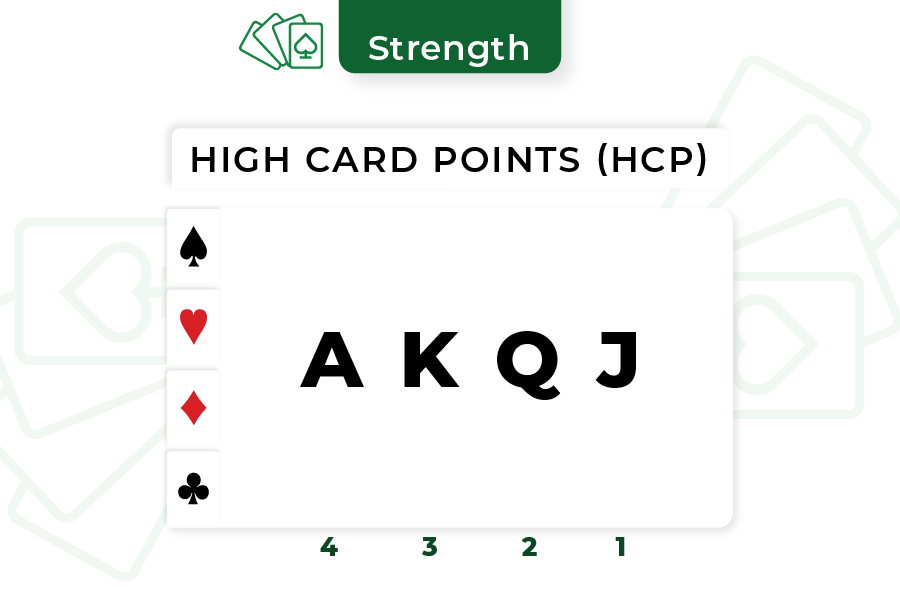
For beginners, we assign the value of points to the top-ranking cards. They're called High Card Points (HCP).
A's and K's are worth a little more than their assigned value, while Q's and J's are worth a little less. Also consider 10's and 9's, especially if they're in your long suits.
Even though we do not officially give them HCPs, they are not worthless in longer suits.
Since each suit has one AKQJ, 4+3+2+1 = 10, and there are 4 suits, spades, hearts, diamonds, and clubs.
There are a total of 40 HCP. So the average hand is about 10 HCP per player.
Shape
Shape refers to how well 2 hands fit together. Generally, the essential factor about shape is how many trumps the two hands have combined.
Then there are many other factors such as having short suits on the side, long suits on the side of the two hands, having 2 fitting suits, if the two hands are mirrored or have an uneven shape on the side, to name a few.
Let's take a look at a few examples:
The first two extreme examples I'll show are the least number of HCP possible to make a small slam (losing only 1 trick) and a grand slam (losing no tricks). If you fancy yourself clever, see if you can come up with the hands before reading on.
1. Miracle Grand Slam
Here you have 11 spades, so if spades are trump, there are only 2 spade cards out there: the K and the Q. If each opponent has one, you can pull all trumps by just playing the A of spades.
South has 8 hearts, so only the AKQJ10 of hearts are out. You can just ruff hearts 3 times (2-3). Then all the hearts are good, giving you all 13 tricks!
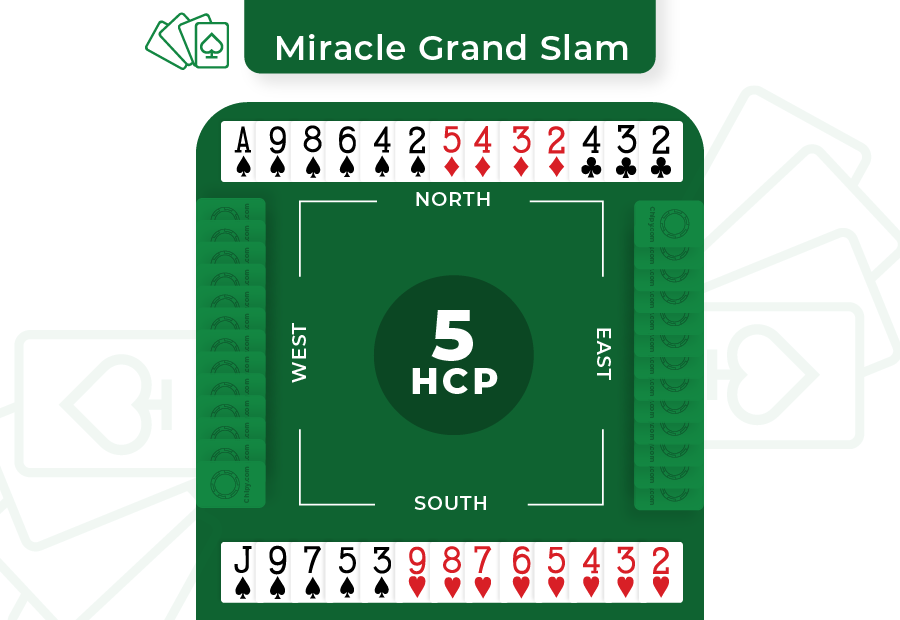
Here's the full play:
Whatever they lead you ruff a spade, you play the A of spades or a spade to the A, depending on where you ruffed.
You can then cross ruff (ruffing the minors in the south with your spades and ruffing your hearts in the north). After ruffing 3 hearts (2-3 heart split for the opponents is likely, about 68% chance), your hearts are now all good, and the south hand has nothing but winners.
So it's possible to make a grand slam on only 5 HCP!!!
2. Miracle Small Slam
This is very similar to the last hand.
You play one round of spades and the AK both drop, then keep ruffing hearts until there’s no more hearts.
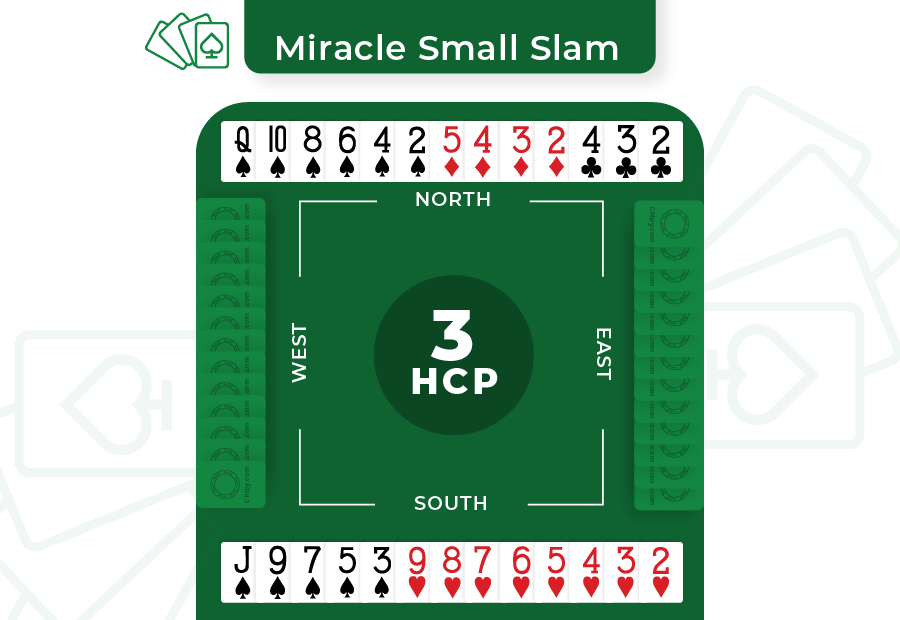
Making a small slam, only 3 HCP!
3. Why is mirror distribution bad?
Let's look at 2 more hands.
AK1098 A109 1098 109
QJ765 876 A76 A8

This hand has great spades for trump, but those extra trumps aren't that useful because you can't ruff anything. You'll likely lose 2 hearts, 2 diamonds, and one club. For 10 trumps, all 4 A's, and all the top spades that's not very good. Losing 5 tricks is making only 2 spades (13-5 = 8, 8 is 2 over 6).
AK1098 A5432 32 2
QJ765 2 A5432 A2

This hand has the exact same number of trumps and HCP as the last hand, but here you can probably make 6 spades (losing only one diamond) if diamonds divide well.
Draw trumps and keep ruffing diamonds to set it up; they're much more likely to be 4-2 or 3-3 than 5-1 or 6-0
As you can see, communicating your general strength and shape is very important in figuring out how many tricks you are likely to take during the play.
When picking which suit to be trump, as a general rule of thumb, remember LENGTH before STRENGTH.
What matters is how many trump cards you have, not how good they are.
Would NOT make a good trump suit as you only have 6 of the 13 cards
Would make an excellent trump suit because you have 9 trumps; there are only 4 trumps missing. If you're lucky, they're split 2-2, and you can play 2 rounds of trumps.
The 5 trump cards left could then be used to ruff your other suits.
On a worse day, their trumps are split 3-1. After playing 3 rounds of trumps, you still have 3 trump cards left to ruff losers in the other suits.
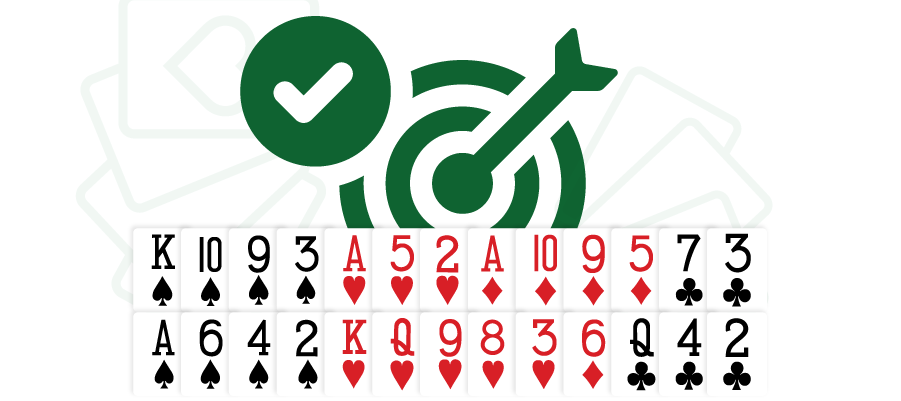
Here are the top 4 things you need to focus on during a bridge bidding phase:
1. Figure out if you guys have a good trump fit
A 7-card fit is generally ok for the 1 and 2 levels. Ideally, you want to find an 8-card fit, but sometimes you don't have one.
For playing a game(3nt, 4 of a major, 5 of a minor), you would generally want at least 8 trumps for a suit contract.
Usually, with 8 trumps, it's better to play in 4 of a major than 3nt, but not so for 5 of a minor as you can only lose 2 tricks in 5 whereas you can lose 4 tricks in 3nt.
2. Find out if you can make a game
Bidding and making a game gives a big juicy bonus.
As a rule of thumb, you need about 25+ total points between you and your partner for a game (total points are HCP + distribution points from good trump fit and shortnesses).
Doubleton is worth 1, singleton 3, void 5, a double fit (2 suits with 8+ cards), or a long side suit (you can ruff and establish a long side suit sometimes for lots of tricks)).
These games are very common. Over half the time, one side can make a game or better.
3. Find out if you can make slam
Slams are a lot rarer than games, but not uncommon. About 14% of the time, one side can make a slam, especially considering the declarer usually has a slight advantage over the defenders during the card play phase.
It's a bit better to see you and your partner's hand during the play than to see one opponent.
Remember
The side that wins the auction has a dummy that gets laid down for everyone to see after a lead is made.
Grand slams are pretty rare. Only about 3% of deals have a grand slam for at least one side (yes, sometimes miracles happen, and both sides can make a slam or, on infrequent occasions, even a grand slam).
4. Figure out if a sacrifice is worth it
Sometimes it's worth it to bid and go down when the opponents score more if they make their contract.
Take a simple example:
You're white on red (your side is NOT VULNERABLE(white)/your opponents are VULNERABLE (red)). Let's say they can take 10 tricks with spades as trump, so they bid to 4 spades. If they play and make it, they score 500 game bonus + 4x30 = 620. Maybe you guys are pretty weak but have a perfect diamond fit.
You can bid 5 diamonds, and even if it goes down by as much as 3 you lose only 100/300/500 for down 1,2,3 doubled, which is better than them scoring 620.
As the saying goes, there's more than one way to skin a cat. This is undoubtedly true of bridge bidding; you can use different bidding systems, each with pros and cons.
Here is an overview of the most popular systems.
2/1 (Two over One)
Difficulty: Beginner, Intermediate, Advanced, Expert
This is by far the most popular system played by bridge players. It is generally regarded as slightly better than SAYC (Standard American Yellow Card), which is a very natural system (you bid the cards you have instead of using a scientifically coded system, if you have a bunch of spades, you bid some number of spades, etc.). You do need 5 or more cards to open a major, and 4 or more diamonds to open 1d.
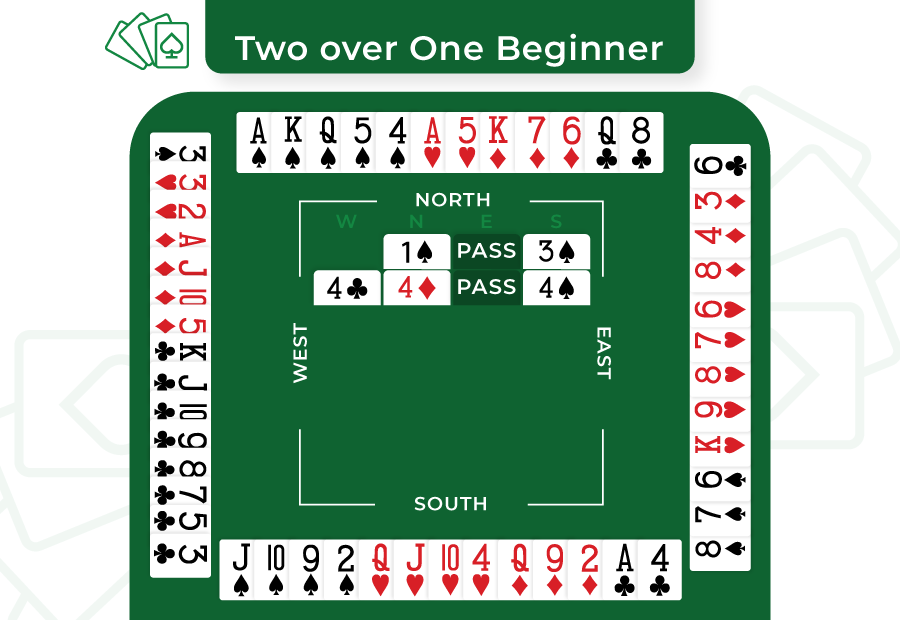

| Pros | Cons |
| Easy to learn | Hard to get the exact shape |
| Leaves a lot of room for judgment and self-expression | Cumbersome wide range for most opening bids of 11 HCP - over 20 HCPs |
| Does well in competitive auctions with stronger hands | Not very scientific for bidding slams, and, to a lesser extent, games |
| The most popular system played, so you can play this with most random players | Hard to open light (with less HCP) due to the wide range. We need about 12 pts to open for beginners and about 11 for intermediate+ |
Basic Precision
Difficulty: Beginner, Intermediate, Advanced
Precision uses 1 club as a solid bid to show a decent 16+, so all the other bids are now limited to 15 or less, letting you open with weaker hands with the range of 10-15.
| Pros | Cons |
| Easy to learn | Hard to get the exact shape |
| Relatively natural | A lot of pressure on the 1c opening as it doesn't tell anything about the shape |
| Most openings have a narrower range of 10-15 HCP | Less commonly played than 2/1, so harder to find partners |
| Allows for slightly lighter openings | |
If you're new to bridge, I recommend skipping the rest of the bidding systems and start reading from “Bridge Opening Bids”.
Relay Precision
Difficulty: Advanced, Expert
Relay Precision has similar opening bids to precision.
However, the key difference is you and your partner quickly determine if you have combined strength to generally make a game (after just 2-3 bids at the 1 level or 2 of a minor).
For instance, one player opens 1c, and the other player with 9 or more HCP already knows a game is likely and will make a bid that shows 9+ pts and give some information.
Then a relay auction starts where one player is the Captain. He is in control of all the decision-making. He doesn't tell his partner anything about his hand and always bids 1 single step every time to ask a series of questions.
His partner has no choice but to answer dutifully. When the Captain is satisfied to play in a specific auction, he bids it. His partner will know the relay is over because the bid is no longer a single step.
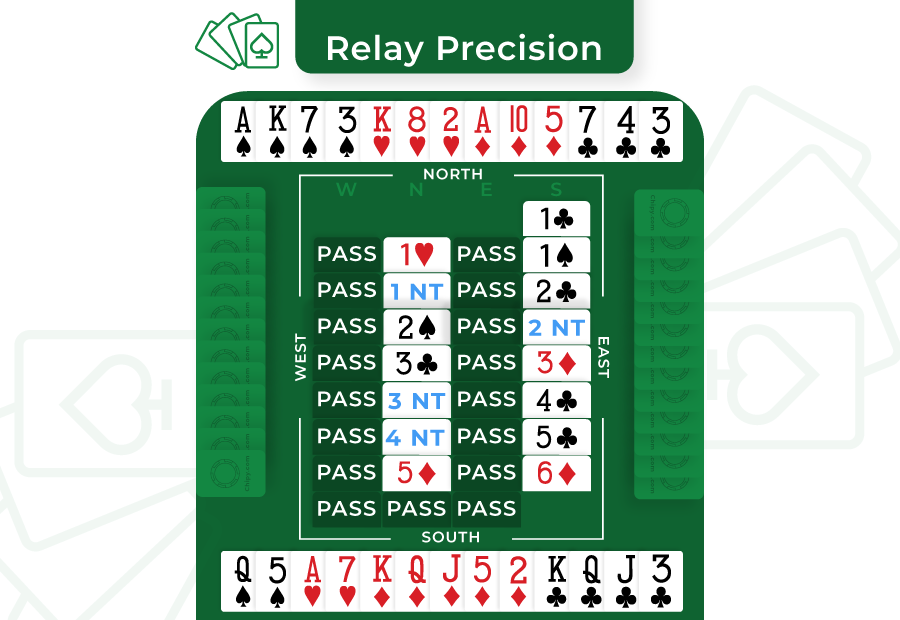
This may sound confusing so let me make up an example (the opponents are silent in this auction, they only bid pass)
- 1c (I have 16+) - 1h (I have 4 or more spades and 9+) a game force is already established*
- 1s (relay, first ask if there’s a 2nd minor suit) - 1nt (no, I do not have a 2nd suit that’s a minor, 2c/2d+ would maybe show a 4+ card minor)
- 2c (relay, now ask about the other major) - 2s(I have 3 hearts, 2d is 0-1, 2h is 2, 2s is now 3)
- 2nt (relay, ask about spades) - 3c(I have 4 spades)
- At this point the captain already knows responder’s exact shape. He has 4 spades, he has 3 hearts, and he doesn’t have a 4 card minor. So he MUST have 4333 shape!
- 3d (relay, tell me how strong you are) - 3nt (I have 13-14 HCP, 3h might be 9-10, 3s 11-12, 3nt would then be 13-14)
- 4c (relay, How many K’s do you have) - 4nt(I have two kings of like rank, 4d would be 0 or 3, 4h would be 1 or 4, 4s would be 2 of the same color(h+d or s+c), 4nt 2 of the same rank (both Major, or both minor), 5c 2 of the same shape (round is h+c, pointed is s+d))
- 5c (relay, How many Q’s do you have) - 5d(0 or 3)
*Because the two players have slam going (16+ and 13-14)values there’s not much missing, it’s usually very easy to work out the difference between zero and 3 and 1 and 4 at this point.
For example here the captain may hold 2 queens so he KNOWS 5d means zero. Note that I didn’t even ask about A’s that’s because by knowing the number of K’s and Q’s you can usually work out how many A’s as the J’s aren’t worth much.
Here responder said he had 13-14 HCP, we know he has 2 kings, and no queens. So that’s 6 HCP meaning he’s got 7-8 Pts left. Lets say the captain holds 2 J’s he can already work out the responder can not have only one A and 3 J’s for the min of 7 HCP as there’s only 2 J’s left. Responder must have 2 A’s.
So responder has 2 A’s, 2 kings of the same rank (both Major or both Minor), no queens and his shape is exactly 4333. You can practically see the entire hand and we’re only at 5d with room to spare to look for grand slam or untangle some ambiguities and uncertainty such as asking the number of J’s or even 10’s on some auctions.
6d(I’ve heard enough, we’re playing here. Note that this is the first bid that’s not a single step for the captain)
Auction without comments:
1c - 1h - 1s - 1nt - 2c - 2s - 2nt - 3c - 3d - 3nt - 4c - 4nt - 5c - 5d - 6d
This is just a made up example, there are lots of ways to build a relay system, best to just look for one online or buy one off some experts who sell their bidding notes (they usually won’t charge an arm and a leg).
There are many ways to build a relay system out there.
However, the general strategy is the same:
- Determine if you have enough for game
- If yes, one player becomes the captain and starts a relay auction where he always bids 1 step until he knows where to play, then he bids it
- The other player will be showing his hand. First, he gives his exact shape. Note that you don't need to give the lengths of all 4 suits, you only need to give the exact lengths of 3 suits, and the length of the 4th suit is known by default.
- Give the exact strength in HCP
- Show the number of K's and Q's (A's and J's will then be known from deduction)
- Show which A's, K's, Q's, then discuss J's if room permits (usually looking for grand)
| Pros | Cons |
| Great for getting the exact shape | 1c faces the same problems as in basic precision |
| Can be very powerful in the right hands and get almost a perfect picture of a hand | Difficult to learn and requires a lot of concentration |
| Fun and rewarding for people looking for a challenge | Based on reason and logic, not natural |
Polish Club
Difficulty: Advanced, Expert
Similar to precision, but one club can be either 11-13 balanced, a strong hand 18+, or a decent hand with clubs 16+
As mentioned before, good players like to mess with a strong club. So the Polish club attempts to address this problem by throwing the weak balanced hand with 11-13 into the mix, making aggressive bidding vs. 1c opener a double-edged sword.
Now most of the time, the 1c is 11-13 balanced (far more frequent than a strong hand), so if opponents tried to mess with it by taking up a lot of space, the 1c opener doesn't care with a boring hand, and the opponents now have to short out their mess with stronger hands and less space to bid.
The drawback is because 1c can be 3 different hand types, it takes some room to sort the 3 out, so you end up with slightly less bidding room and will have to use more complicated tricks to save space.
| Pros | Cons |
| Great for getting exact shape | More to untangle after 1c opening, and even more pressure on the 1c bid |
| Can be very powerful in the right hands and get almost a perfect picture of a hand | Difficult to learn and requires a lot of concentration |
| Fun and rewarding for people looking for a challenge | Not very scientific for bidding slams, and, to a lesser extent, games |
Keep in mind
1c opening shouldn't suffer aggressive interference. If the opponents choose to do so, then they take on significant risk as it's not profitable vs. the frequent 11-13 balanced hands.
Most experts advise treating the polish club as an 11-13 balanced, not as a strong hand, as that's far more common. But because of that, you protect your stronger hands from aggressive interference.
Vision
Difficulty: Advanced, Expert
Vision is a relatively new system developed starting around 20 years ago. It's like the next evolutionary step to precision. The opening bids for 5+ card majors and 2 suiters mostly have a range from 8-13. It capitalizes on the narrow range and abuses the ability to stop at the 1 level.
Most basic systems tend to force to at least 1nt on most given auctions and are designed to play in 1nt, 2 of a major, or 3 of a minor. While those are the most common places to play a partscore, that doesn't mean you have to bid there when you find out your hands are weak.
You can abuse the ability to stay in a low contract for safety and open much lighter with relatively low risk if you have good shape. The problem is when your partner gets carried away thinking you have a good hand because you opened, or fearing you might have 20 HCP and afraid to pass with a relatively weak hand.
But playing vision, your partner knows you are capped out at 13, and with a quick relay, can find out if you're 8-10 or 11-13.
Opening light has some clear benefits. It quickly gives you a place to compete and gets in the opponent's way. Pass now conveys even more information. Not only do you have 10 or less, but if you're 8-10, you probably have a pretty dull hand with nothing worth mentioning.
1c is either 11-13 balanced, or any 14+, or shapely 8-13, any 14+ (10 cards in 2 suits), unlike precision and Polish club, where 1d after 1c opening is the only weak bid. In vision, 1d is the ONLY forcing bid. All other bids are natural or semi-natural with 8 or fewer pts and can be passed.
| Pros | Cons |
| Great for getting exact shape | More to untangle after the 1c opening, and even more pressure on the 1c bid |
| Can be very powerful in the right hands and get almost a perfect picture of a hand | Difficult to learn |
| Fun and rewarding for people looking for a challenge | Based on reason and logic, not natural |
| 1c opening shouldn't suffer aggressive interference | Requires a lot of concentration |
| Can open supper light | Can't play with a random partner, must be played with a long-term regular partner |
These are oversimplified explanations of the general approach to each system. Mastering any system will take years, if not decades.
There are many other systems, such as Fantunes, that I won't mention, and I'm sure there are many systems I'm not aware of. There are even "home grown" systems that established partners design themselves. Designing your own systems can be a lot of fun, but it's a lot of work.
Unless you really know what you're doing, the results probably won't be outstanding. How to design a good system is a science of its own. Common techniques such as relays, transfers, and multi-bids are employed to maximize the usage of the bidding space.
It would be nearly impossible to review every bidding system since the mechanic is constantly evolving.
Because 2/1 is by far the most played and relatively easy to learn.
We will focus only on the 2/1 bidding system.
Note: all bids are general guidelines and not absolute. It would be impossible to cover all the nuances.
Opening Bids For Beginners
Finding an 8-card major fit is one of the priorities of bidding.
The simplest and most effective way to find a major fit is for the opener to only open a major if they have 5 or more.
To find 4-4 fits opener opens a minor, and the responder shows majors with 4 or more. Opening a minor is generally better because it leaves more room for the responder to bid.
- 1 Spades - 12-21 HCP, 5+ spades;
- 1 Hearts - 12-21 HCP 5+ hearts;
- 1 Diamonds - 12-21 HCP 4+ diamonds usually no 5 card major;
- 1 Clubs - 12-21 HCP 2+ clubs (can be 4432 shape), usually no 5 card major.
Usually, you will have at least 3 clubs unless you have 4 spades, 4 hearts, 3 diamonds.
Because you don't have a 5 card major or 4 diamonds, you must open 1c. If you have 4 diamonds and 5 or more clubs open 1c not 1d.
1nt - 15-17 HCP, balanced (can have 5 card major, can have 6 card minor, no singleton major)
With 6 card suits, you can open with a little less like 10-11 HCP.
With good honors A/K, or good shape such as two 5 card suits, or spots 10's and 9's in your long suits, don't be afraid to upgrade and open. It's better to be aggressive and play around to find out what works and doesn't work than to be conservative and never improve.
- 2 Clubs - 22+
- 2nt - 20-21 balanced/semi-balanced
- 3nt - undefined (don't open this)
Most higher level bids DO NOT show good hands, they show weak hands with long suits, designed to get in the way of the opponents and are often bid as preemptive sacrifices.
Preempts:
- 2 Clubs / Hearts / Diamonds - 3-9 HCP, 6 card suits.
- 3 Spades / Hearts / Diamonds / Clubs - 3-9 HCP, 7 card suits
- 4 Spades / Hearts / Diamonds / Clubs 5 Diamonds / Clubs - 3-9 HCP, 8 card suits/8 card suits with extra good shape on the side
Do NOT preempt in 4th seat pass if you're below average in strength
Other notes
If you have two 5 card suits or two 6 card suits (very rare) always open the higher ranking suit then bid the lower one so your partner can choose at an equal level.
If you have a 5 card major and a 6+ card minor. Open the minor if it's a good suit (about KQ109xx or better) and your hand is decent 12+ HCP, you will try to open the minor then bid the major twice. Open the major if the minor isn't great or you're on the weaker side, you will open the major and bid the minor twice (note how this leaves more room and stays lower).
Opening Bids For Advanced Players
- 1 Spades - 11 to less than 2c, 5+ spades
- 1 Hearts - 11 to less than 2c, 5+ hearts
- 1 Diamonds - 11 to less than 2c, usually 5+ diamonds, usually no 5 card major
- 1 Clubs - 11 to less than 2c, 2+ clubs, usually no 5 card major. Play transfer response to 1♣
Passing the worst 11s that REALLY look like 10 is fine.
1nt - 14 - bad 17 HCP, balanced (can have 5 card major but not 6, can have 6 card minor or 7 card minor with 7222 shape and scattered values, no singleton major unless it's an A, singleton minor is acceptable). Strain to open 1nt when you have difficulty describing your strength on the 2nd bid. When you have a good 16 or 17 and can reverse, consider not opening 1nt with a slightly unbalanced hand, say (42)(52) shape.
Don't be afraid to upgrade 9/10 HCP and open with 5-5 shape or 6 card suits or 10 counts with 5431 shape and all honors working in longer suits.
2c - 3 and a half losers or less with a major re-bid, 3 or fewer losers with a minor re-bid, or 22+ balanced, or weak 2 in diamonds (2 diamonds will be used for multi)
Losing trick count
Losing trick count is if you pretend your partner has 3 little cards in every suit. If you can lead from his side twice, how many tricks will you lose on relatively friendly splits.
At the end of the day bridge is about how many tricks you expect to take, not how many HCP's you have, so Losing trick count is often a better way of evaluating hands.
Let's have a look at some examples:
1. AQJ1063 KQ7 AK52 6
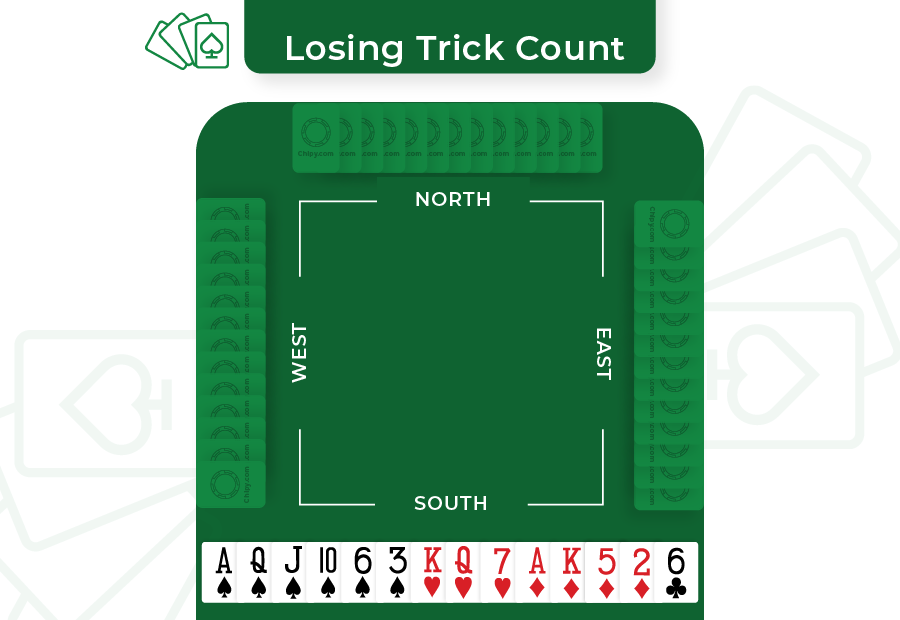
The spade hook will work 50% of the time, so you have half a loser in spades.
Now look at the hearts. If RHO has the A of hearts, then you could lead hearts twice and score both the K and the Q, but if LHO has the A, then the A takes one of your K/Q, and you will lose 2 tricks. So that's 1 and a half losers in hearts. For diamonds, you always only look at the first 3 cards. You assume lengths 4 or longer are winners. So You have one diamond loser (in reality, it's a little more than one). You only lose 1 club.
So this hand has 1/2 spade loser + 1 1/2 heart losers + 1 diamond loser + 1 club loser, BUT because to finesse spades and hearts twice, that requires you to be able to lead 3 times from the board so it's closer to a 5 loser hand. So definitely open 1s, not 2c.
2. KQJ10932 2 AKJ2 2

This hand has a lot fewer HCP, only 14, whereas the previous hand had 19, but this hand is MUCH better. It only has 1 spade loser, 1 heart loser, 1/2 diamond loser, 1 club loser. 3 1/2 losers total, I would open this 2c.
With unbalanced hands, LTC (losing trick count) is much more effective than counting HCPs.
LTC also works fairly well for balanced hands. Usually, a hand with 7 or fewer losers is worth opening at the 1 level. More losers than that, pass or preempt.
- 2nt - 20-21 balanced/semi-balanced
- 3nt - I don't recommend gambling 3nt (solid 7-card minor headed by AKQ and nothing else) as it wrong sides the contract. Better to use it to show a weak hand with 6-6 minors or Kantar 3nt (Solid 7+ card major headed by AKQ with no outside A's and at most one outside K and not much more)
Preempts:
- Multi 2 Diamond - A preempt in EITHER Major, 3-9 HCP white, 6-9 HCP red, 2nd seat always good suits (at least KQ109xx), 8-10 2nd seat red on white, 6 card suits. *Optional* can also be strong 4441 shape 16+ HCP hands.
- 2 Spades/Hearts - Intermediate 2’s. 9-12 HCP with good shape (5431, 4 cards not in the other major, or 6 card suits)
- 3 any suit - 3-9 HCP white, 6-9 HCP red, 2nd seat always good suits ( at least KQ109xxx) 8-10 2nd seat red on white, 7 card suits, when vulnerable consider preempting one level less and open 2♢ instead of 3 with a weaker/less shapely hand and 7 card suit.
- 4 Spades/Heart or 5 Diamond/Clubs - weak, 8 card suits/8 card suits with extra good shape on the side
- 4 Clubs - Namyats (staymen spelled backward), AKxxxxx or better in hearts with outside A or void, A good 4 heart preempt with slam interest opposite 2 A's and something extra (such as Q or singleton),
- 4 Diamonds - Namyats, Same as 4 Clubs, but for spades instead of hearts.
DO NOT preempt with a 4-card major on the side.
4th seat "preempts" show sound (12+ power) but min (13 or less) openers with good shape and extra trump. Unlikely to make a game opposite passed hands, but you're favorite to make. You wouldn't open in the 4th seat trying to go down, you can just pass.
Other notes
If you have two 5-card suits or two 6-card suits (very rare), always open the higher-ranking suit and then bid the lower one so your partner can choose at an equal level.
If you have a 5-card major and a 6+ card minor. If it's a good suit (about KQ109xx or better) and your hand is decent 12+ HCP, you will try to open the minor and then bid the major twice. If the minor isn't great or you're on the weaker side, you will open the major and bid the minor twice (note how this leaves more room and stays lower).
Key takeaways
Bidding is about communicating with your partner what cards you have and figure out the best contract to play in during the play phase to get the best possible score.
Remember
You should first master card play, you can’t fully understand bidding without having a good idea of how the cards play out during the play phase. Go to BBO, go to practice, and do some bridge master play puzzles.
There are many bidding systems you can use, such as:
- 2/1 (2 over 1)
- Precision
- Polish Club
- Vision
- Fantunes
Each system comes with pros and cons. 2/1 is by far the most common and will be our focus here.
Generally you should open with an above average hand OR a really long suit (6 or more). If you’re weak (bad 9 or less HCP) with a long suit you should usually preempt by bidding the suit at the 2 level or higher. You’re not trying to make the contract, you're trying to be annoying and steal from your opponents.
Bidding is about communication, there are many bids with special meanings that are not natural. They mean something specific but may have nothing to do with the suit that’s bid.
We will go over in detail continuations to each opening bid in future articles. Stay tuned in the Bridge Academy for more guides!
Meanwhile try playing bridge on BBO or check out if there’s any local bridge clubs near you.
Happy hunting!

Bonuses
Casinos
Games
Academy
News
Shop
NEW Q&A
Sweepstakes















